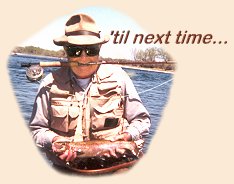
| ||
|
February 16th, 2004
|
|
Q. I read an article in a fly fishing magazine written by a man named Al Caucci (of the Delaware River Club) in which he made reference to a mayfly he calls Ephemerella "X". This species is related to E. subvaria and is also referred to by Mr. Caucci as the Dark Hendrickson. (He included that name for the benefit of us fly fisherman, as the term Dark Hendrickson has no scientific meaning, as you know). I have never seen any other reference to this mayfly in any other publication. Did he discover a new species or is E."X" some other previously identified mayfly that he misidentified? Who decides what is or isn't a new insect species and what it's Latin name will be? Are there debates in the entomology world over how to classify different insects? Have there been any new mayfly species discovered recently?
A.
Response: These are excellent questions, and I
will address them in order.
Regarding Ephemerella "X." Now I do not
know what Mr. Caucci intends by his use of this term,
but I will explain its use in the scientific literature,
which is probably the same. Remember that the
identification of adult mayflies to the species level
is well known; the problem is that we simply do not
have the knowledge to identify all of the nymphs to
species. Thus, you will often see in species lists
from a particular stream a list which may include,
for example, Baetis vagans, Baetis
sp. a, and Baetis sp. b, with the
appropriate data after each name. What this indicates
is that the scientist had three different Baetis
species in his stream - one that could be positively
identified as B. vagans, and two that were
definitely of the genus Baetis, different
from each other, but not identifiable to the species
level. He may further indicate that further studies
were being undertaken to either (1) rear the two
unidentified species to adults so that they could
then be positively identified, or (2) have the two
unidentified species examined by an expert taxonomist
who might, or might not, be able to identify them to
species. In some cases, it is entirely possible that
an unidentified species might turn out to be a new
species; this happens frequently, especially if the
specimens are from a little studied area or type of
habitat. I suspect that Mr. Caucci was simply using "x"
as I did "sp. a." In 1976, Edmonds, Jensen, and Berner
listed 28 different species of Ephemerella. Further,
since most of these are only identifiable from adults,
I tend to be a bit hesitant before accepting species
identifications of immatures unless I know that the
person has the necessary equipment and knowledge to
determine these. This isn't meant to suggest that
Mr. Caucci doesn't know his business; I just get
uneasy when most of the fishing literature always
seems to have E. subvaria listed, whereas this species
only is known from the Northeast and Central U.S.
Why don't fishermen ever find any of the other 27
species? Enough of that bandwagon.
Your second question about whether it is a new species
or a previously misidentified mayfly has probably been
answered by the above. It could be a new species or
one that Mr. Caucci knew was of the genus Ephemerella,
but a different species from what he knew to be
E. subvaria.
New species can be described and identified by
anybody, although you better have some good
credentials in taxonomy for that particular
group of insects. There are many scientists
who have devoted their careers to sorting out
the taxonomy of a particular group, and it is
usually these folks who decide, or at least are
consulted, when a new species is suspected. There
is an extensive protocol to doing this and it includes
publishing the complete description and measurements
of the insect in certain languages, description of
the habitat where it was found, where the original
specimen is stored, etc., etc. The Latin name for
the species, too, is selected by whoever is describing
the new species and is sometimes named to honor somebody,
or a place, or something descriptive of the organism.
This leads into your next question about debates. It
may be that a newly found insect may not even fit into
one of the existing genera or families, and in this
case, it will not only be a new species but also a
new genus and, perhaps, family. There are taxonomists,
as I pointed out above, who do nothing but study, evaluate,
and determine the correct lineages of various insect groups.
Further, it is not uncommon for a person to decide that
based on his extensive studies, he has decided that
major changes are necessary in the groupings. Perhaps
a family that contained 7 genera should be revised into
two families with 4 genera in one and 3 in the other.
Or maybe a subfamily or superfamily needs to be established
to sort things out. New family or other names may be
needed. This goes on continuously and is undergoing
major changes now. This is because up to fairly recent
times, all of this was done on morphological, behavioral,
and evolutionary characteristics. Now, DNA analyses are
showing that previously established relationships may
or may not be valid. It is causing considerable
consternation in the scientific community, especially
for the poor field ecologist who formerly could do a
pretty good job with a microscope and the correct keys,
but now needs a DNA analytical lab. You can't take that
into the field with you.
I don't know how many new species of mayflies have been
discovered recently, but you can be sure that it is
happening. There are more than 700 species of mayflies
identified from North America north of Mexico, so you
can see that the folks who like to variously lump and
split these into different groupings have enough work
to last several careers.
You've probably now read more than you ever wanted to
on the subject, but you got me going on a subject that
has no easy, short answers. If I've just further
confused the issue, let me know and I'll try to
clarify things for you.
~ C. E. (Bert) Cushing, aka Streamdoctor 105 W. Cherokee Dr. Estes Park, CO 80517 Phone: 970-577-1584 Email: streamdoctor@aol.com
|
| If you would like to comment on this or any other article please feel free to post your views on the FAOL Bulletin Board! |
[ HOME ]
[ Search ] [ Contact FAOL ] [ Media Kit ]
 The 'Stream Doctor' is a retired professional stream ecologist and
author, now living in the West and spending way too much time
fly-fishing. You are invited to submit questions relating to
anything stream related directly to him for use in this Q & A Feature
at
The 'Stream Doctor' is a retired professional stream ecologist and
author, now living in the West and spending way too much time
fly-fishing. You are invited to submit questions relating to
anything stream related directly to him for use in this Q & A Feature
at